Trends in the Social Security and Supplemental Security Income Disability Programs
Entry into and Exit from the Disability Programs
Introduction
This section provides further insight into the size of the disability programs by examining, from year to year, the number of persons entering and leaving each program. In addition to entry and exit, the size of the program is influenced by one other factor: duration of the stay. Duration is largely a factor of the age of entrants and their diagnosis, both of which influence the amount of time they are likely to remain on the rolls.
Entry into the disability programs is measured by the number of disability awards for each program. It is not always clear how many individuals enter the programs because in some benefit categories, such as disabled adult children, the individual may leave the benefit category as a beneficiary of the Disability Insurance Trust Fund and immediately enter the same benefit category as a beneficiary of the Old-Age and Survivors Insurance Trust Fund. For this reason, this section focuses on disabled workers and SSI recipients. The reader is also cautioned that some individuals may enter both disability programs at the same time, or nearly the same time, depending on the waiting period and other factors. Thus, simply adding the number of entrants to the programs will yield a total that is greater than the total number of unique individuals entering the programs.
The termination of benefits in the Social Security disability program is based predominantly on four factors: conversion to the retirement program (that is, attainment of full retirement age), death, medical recovery, and work recovery. In addition, benefits to disabled widow(er)s and disabled adult children can be terminated for marriage or for entitlement to a larger benefit.
In the SSI program, termination is a quite different concept. Although payments are terminated for death and medical recovery, suspension of payments is common, particularly for financial reasons. Payments may be suspended because the recipient has excess earnings, excess unearned income, excess resources, or a change in living arrangements. For the purposes of this book, individuals who have had their SSI payments suspended for 12 months or longer are considered terminated from the SSI program.
There are other differences in the reasons for termination between the Social Security and SSI programs. For blind and disabled adults in the SSI program, there is no conversion to the aged category at age 65; the disability designation continues although medical recovery is no longer an issue after the age of 65. There is no termination for substantial gainful activity in the SSI program: benefits are reduced $1 for each $2 of earnings exceeding $65 per month until cash benefits are no longer paid. Even after cash benefits are suspended because of earnings, eligibility for Medicaid benefits can be maintained under the provisions of section 1619b. SSI disabled children are subject to a redetermination at the age of 18, during which an assessment is made as to whether they meet adult disability standards. Nearly one in three SSI children is terminated at the age of 18 for not meeting the adult standards.
Entry and Exit by Disabled Workers
Number and rate of awards and terminations
The number and rate of entry and exit by disabled workers in the Social Security Disability Insurance (DI) program vary considerably over time. The number of awards is at a historical high. The rate of entry, though currently rising, is considerably lower than peaks reached in the mid-1970s. Although the number of terminations is relatively high by historical standards, the rate of terminations has been generally falling since the early 1980s.
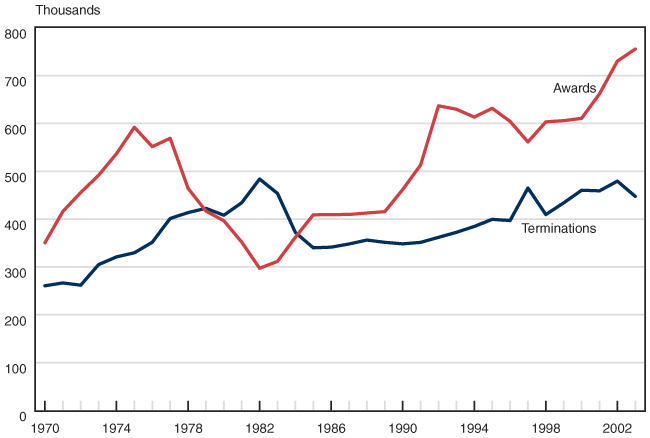
| Year | Awards | Terminations |
|---|---|---|
| 1970 | 350,384 | 260,444 |
| 1971 | 415,900 | 266,471 |
| 1972 | 455,400 | 261,739 |
| 1973 | 491,600 | 304,792 |
| 1974 | 536,000 | 320,958 |
| 1975 | 592,049 | 329,532 |
| 1976 | 551,500 | 351,504 |
| 1977 | 568,900 | 401,334 |
| 1978 | 464,400 | 413,571 |
| 1979 | 416,700 | 422,503 |
| 1980 | 396,559 | 408,051 |
| 1981 | 351,847 | 434,187 |
| 1982 | 297,131 | 483,847 |
| 1983 | 311,549 | 453,621 |
| 1984 | 361,998 | 371,913 |
| 1985 | 408,900 | 339,984 |
| 1986 | 409,400 | 341,276 |
| 1987 | 409,600 | 347,948 |
| 1988 | 412,700 | 356,143 |
| 1989 | 415,500 | 351,402 |
| 1990 | 461,800 | 348,194 |
| 1991 | 513,100 | 351,303 |
| 1992 | 636,900 | 361,796 |
| 1993 | 629,700 | 372,317 |
| 1994 | 613,300 | 384,590 |
| 1995 | 631,600 | 399,475 |
| 1996 | 604,000 | 396,980 |
| 1997 | 561,300 | 464,984 |
| 1998 | 603,300 | 409,489 |
| 1999 | 605,800 | 433,950 |
| 2000 | 610,700 | 460,351 |
| 2001 | 661,900 | 459,073 |
| 2002 | 730,383 | 479,364 |
| 2003 | 755,706 | 447,485 |
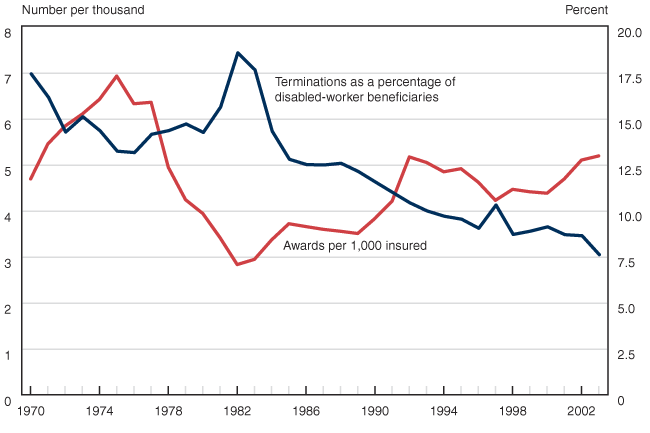
| Year | Terminations as a percentage of disabled-worker beneficiaries |
Awards per 1,000 insured |
|---|---|---|
| 1970 | 17.44 | 4.70 |
| 1971 | 16.17 | 5.47 |
| 1972 | 14.28 | 5.85 |
| 1973 | 15.11 | 6.11 |
| 1974 | 14.35 | 6.43 |
| 1975 | 13.24 | 6.94 |
| 1976 | 13.16 | 6.34 |
| 1977 | 14.16 | 6.37 |
| 1978 | 14.36 | 4.96 |
| 1979 | 14.72 | 4.25 |
| 1980 | 14.26 | 3.95 |
| 1981 | 15.64 | 3.43 |
| 1982 | 18.58 | 2.84 |
| 1983 | 17.66 | 2.96 |
| 1984 | 14.32 | 3.38 |
| 1985 | 12.80 | 3.73 |
| 1986 | 12.51 | 3.67 |
| 1987 | 12.49 | 3.61 |
| 1988 | 12.58 | 3.57 |
| 1989 | 12.14 | 3.52 |
| 1990 | 11.56 | 3.85 |
| 1991 | 11.00 | 4.22 |
| 1992 | 10.43 | 5.18 |
| 1993 | 9.99 | 5.06 |
| 1994 | 9.70 | 4.86 |
| 1995 | 9.54 | 4.93 |
| 1996 | 9.05 | 4.64 |
| 1997 | 10.31 | 4.24 |
| 1998 | 8.72 | 4.48 |
| 1999 | 8.89 | 4.43 |
| 2000 | 9.13 | 4.39 |
| 2001 | 8.70 | 4.70 |
| 2002 | 8.65 | 5.11 |
| 2003 | 7.62 | 5.20 |
The number of annual awards to disabled workers rose from 1970 to 1975, declined until 1982, and has generally been increasing since then (Chart 21). The rate of program entry, measured as the number of awards to disabled workers per 1,000 persons insured for disability, provides a better idea of the relative size of program entry and tends to vary over time (Chart 22). This measure reached a historical high in the mid-1970s—increases often attributed to a poor economy, increasing incentives from higher benefits, the addition of Medicare, and the establishment of the SSI program in 1974. The decline from 1975 to 1982 was the result of legislation and policy changes that tightened program eligibility and reduced benefit levels. Since that time, the entry rates into the DI program have risen, though not consistently, and are considerably lower than the peak level of the 1970s.
The number of exits, or terminations, rose until 1982, when it fell for a few years because of the moratorium on continuing disability reviews. The number of terminations has increased since the mid-1980s and in 2002 was close to the historical peak reached in 1982. Terminations declined in 2003, in part because of the increase in the full retirement age in that year from age 65 to age 65 and 2 months (Chart 21).
Exits of disabled workers from the DI program, as a percentage of disabled-worker beneficiaries, have varied over time, reaching a peak in 1982 when the pace of continuing disability reviews accelerated, producing large numbers of terminations due to recovery that increased the overall termination rate.1 Since that time, the medical improvement review standard, along with demographic and diagnostic trends, has led to reductions in the overall termination rate. One notable exception occurred in 1997, when legislation resulted in the review and termination of persons who had been entitled on the basis of drug addiction and alcoholism, contributing to a temporary increase in the overall rate of termination. Noteworthy demographic trends include more baby boomers entering the program (which has resulted in a change in the age distribution of beneficiaries and thus relatively fewer persons reaching retirement age each year) and more allowances for persons with mental disorders, who tend to stay on the rolls longer. Recently the increase in the retirement age has reduced the number of exits that would be due to conversion to the retirement program.
Entry and Exit by SSI Blind and Disabled Adults and Children
Number and rate of awards and terminations
The number of SSI awards and terminations and the entry and exit rates for disabled SSI recipients under 65 years of age have varied over time. The number of awards in 1993 was more than 3½ times that in 1982, and the entry rate was nearly 3 times as great. The rate of terminations has shown less variation, running between 10 percent and 13 percent of recipients since the late 1970s.
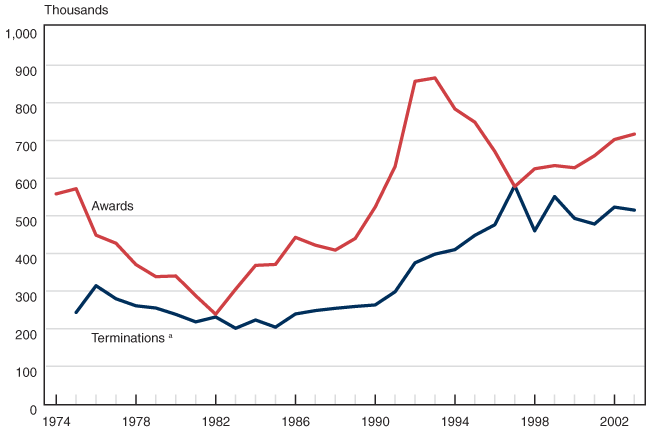
| Year | Terminations a | Awards |
|---|---|---|
| 1974 | . . . | 558,050 |
| 1975 | 242,970 | 571,830 |
| 1976 | 314,083 | 448,380 |
| 1977 | 279,373 | 426,920 |
| 1978 | 260,748 | 370,220 |
| 1979 | 254,822 | 338,190 |
| 1980 | 238,000 | 340,000 |
| 1981 | 218,000 | 287,390 |
| 1982 | 231,000 | 238,260 |
| 1983 | 201,000 | 304,770 |
| 1984 | 223,000 | 368,130 |
| 1985 | 204,000 | 370,660 |
| 1986 | 239,000 | 442,620 |
| 1987 | 248,000 | 421,800 |
| 1988 | 254,000 | 408,630 |
| 1989 | 259,000 | 439,640 |
| 1990 | 263,000 | 523,010 |
| 1991 | 298,000 | 631,050 |
| 1992 | 375,000 | 857,380 |
| 1993 | 398,000 | 866,250 |
| 1994 | 410,000 | 783,830 |
| 1995 | 448,000 | 748,630 |
| 1996 | 476,000 | 670,960 |
| 1997 | 580,000 | 577,540 |
| 1998 | 460,000 | 624,840 |
| 1999 | 551,000 | 633,360 |
| 2000 | 493,000 | 627,560 |
| 2001 | 478,000 | 659,490 |
| 2002 | 523,000 | 702,600 |
| 2003 | 515,000 | 717,010 |
| NOTE: . . . = not applicable. | ||
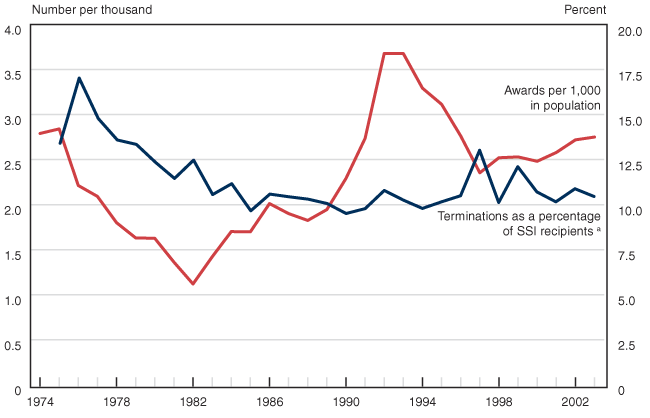
| Year | Terminations as a percentage of SSI recipients a |
Awards per 1,000 in population |
|---|---|---|
| 1974 | . . . | 2.79 |
| 1975 | 13.45 | 2.84 |
| 1976 | 17.08 | 2.21 |
| 1977 | 14.83 | 2.09 |
| 1978 | 13.63 | 1.80 |
| 1979 | 13.38 | 1.63 |
| 1980 | 12.39 | 1.63 |
| 1981 | 11.49 | 1.36 |
| 1982 | 12.51 | 1.12 |
| 1983 | 10.59 | 1.42 |
| 1984 | 11.19 | 1.70 |
| 1985 | 9.68 | 1.70 |
| 1986 | 10.61 | 2.01 |
| 1987 | 10.47 | 1.90 |
| 1988 | 10.33 | 1.83 |
| 1989 | 10.09 | 1.95 |
| 1990 | 9.53 | 2.29 |
| 1991 | 9.81 | 2.74 |
| 1992 | 10.82 | 3.68 |
| 1993 | 10.28 | 3.68 |
| 1994 | 9.82 | 3.29 |
| 1995 | 10.18 | 3.11 |
| 1996 | 10.52 | 2.76 |
| 1997 | 13.06 | 2.35 |
| 1998 | 10.15 | 2.52 |
| 1999 | 12.14 | 2.53 |
| 2000 | 10.74 | 2.48 |
| 2001 | 10.18 | 2.58 |
| 2002 | 10.91 | 2.72 |
| 2003 | 10.48 | 2.75 |
| . . . = not applicable. | ||
The number of awards of SSI to disabled recipients has varied over time, declining from 1975 to 1982, before increasing rapidly from 1983 to 1993 (Chart 23). The number of awards in 1993 was more than 3½ times the number of awards in 1982.
The entry rate is based on the number of SSI awards per 1,000 in the population aged 0–64 (Chart 24). SSI entry reached a low of 1.1 awards per 1,000 in 1982, before rising to a peak of 3.7 per 1,000 in 1992. This increase in awards is due, in part, to the Zebley decision and to Congressionally mandated SSI outreach efforts in the early 1990s. The SSI entry rate stabilized in 1997 after 4 years of declines.
Exit from the SSI program can be due to death, medical recovery, excess income (earned or unearned), excess resources, or a change in living arrangements. In many cases, for instance when dealing with excess income, payments are suspended. Suspension of payments for 12 months or longer is generally considered a termination for SSI program purposes, and as such it is counted as a termination in this book. There is no termination for substantial gainful activity. However, payments are reduced $1 for every $2 earned in a month above a $65 earned income disregard, and cash payments can be eliminated under this offset. Even if cash payments end because of earnings, eligibility for Medicaid can continue under the provisions of section 1619b.
The number of exits from the SSI program declined from 1976 until the mid-1980s (Chart 23). Since 1985 the number of terminations has increased considerably, peaking in 1997 because of welfare reform and other changes.
The SSI exit rate, as a proportion of SSI recipients, has generally fluctuated in a narrow band of 10 percent to 13 percent since the late 1970s (Chart 24). Terminations trended downward in the early 1980s, before the exit rate stabilized for nearly a decade beginning in 1985. In the 1990s, the exit rate increased in 2 years: in 1997 and again in 1999. The increase in 1997 is directly related to two pieces of legislation from 1996: P.L. 104-121, which eliminated drug addiction and alcoholism as a disability, and P.L. 104-193, which changed the definition of disability for SSI children and mandated the review of certain SSI childhood cases. The decrease in 1998 and subsequent increase in 1999 reflect SSA administrative policies that rereviewed SSI children who were terminated as the result of welfare reform and were offered continuation of payments to permit appeals on those cases. The increase in the rate of exit in 1999 reflects, in part, final dispositions of the reviews of SSI children.
Entry by Disabled Workers
Number of awards, by sex
The number of disabled-worker awards has varied over time for both sexes; however, the number of awards has been generally increasing since the early 1980s. Awards to women have been increasing more rapidly than have those for men, both in absolute numbers and as a percentage of awards.
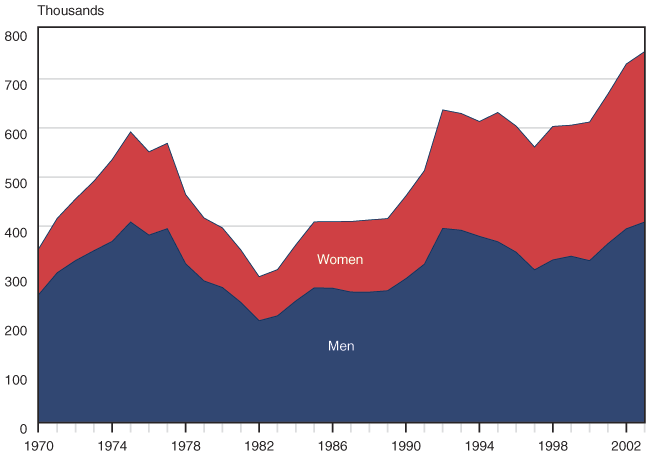
| Year | Men | Women |
|---|---|---|
| 1970 | 258.07 | 92.31 |
| 1971 | 305.10 | 110.80 |
| 1972 | 330.01 | 125.43 |
| 1973 | 350.07 | 141.55 |
| 1974 | 369.16 | 166.82 |
| 1975 | 408.53 | 183.52 |
| 1976 | 381.89 | 169.57 |
| 1977 | 394.97 | 173.90 |
| 1978 | 323.48 | 140.93 |
| 1979 | 288.54 | 128.17 |
| 1980 | 275.19 | 121.37 |
| 1981 | 244.98 | 106.86 |
| 1982 | 207.45 | 89.68 |
| 1983 | 217.42 | 94.13 |
| 1984 | 247.83 | 114.17 |
| 1985 | 274.40 | 134.50 |
| 1986 | 273.70 | 135.70 |
| 1987 | 265.90 | 143.70 |
| 1988 | 265.70 | 147.00 |
| 1989 | 268.60 | 146.90 |
| 1990 | 293.30 | 168.50 |
| 1991 | 322.70 | 190.40 |
| 1992 | 395.60 | 241.30 |
| 1993 | 391.80 | 237.90 |
| 1994 | 379.30 | 234.00 |
| 1995 | 368.40 | 263.20 |
| 1996 | 347.10 | 256.90 |
| 1997 | 311.10 | 250.20 |
| 1998 | 331.40 | 271.90 |
| 1999 | 338.90 | 266.90 |
| 2000 | 329.80 | 282.40 |
| 2001 | 364.50 | 304.80 |
| 2002 | 394.74 | 335.64 |
| 2003 | 408.52 | 347.19 |
Disabled-worker awards have fluctuated over the period for both sexes. However, since the early 1980s there has been a clear pattern of increase in the number of awards to women. In fact, the proportion of awards to women has increased fairly consistently over the entire period, rising from 26 percent in 1970 to 46 percent in 2003. Although the fact that more women have participated in the labor force and the rate of insured status has played a role in increased awards to women, disabled-worker incidence rates for women have also increased and are now similar to the incidence rates for men. Changes in the structure of occupations generally, as well as the trend toward women filling jobs traditionally held by men, may play a role, as may trends in the incidence of various disabling impairments.
Percentage distribution of awards, by age
Since 1970, older workers (aged 60 and older) have constituted a generally decreasing share of new disabled-worker awards. Persons in the middle age groups—those aged 40–49 and 50–59—have represented an increasing percentage of worker awards.
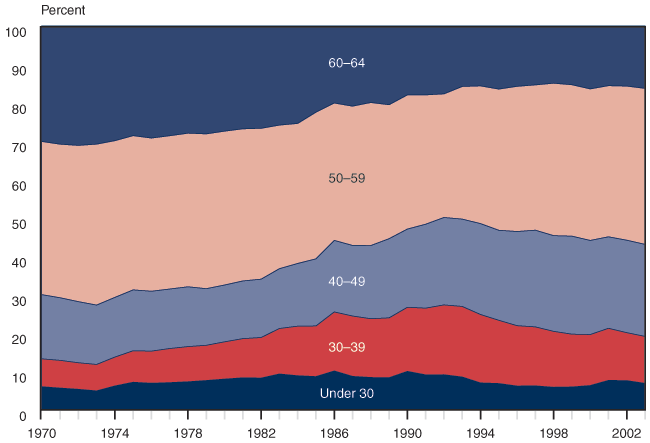
| Year | Under 30 | 30–39 | 40–49 | 50–59 | 60–64 |
|---|---|---|---|---|---|
| 1970 | 6.04 | 7.25 | 16.72 | 39.89 | 30.09 |
| 1971 | 5.69 | 7.22 | 16.31 | 39.99 | 30.80 |
| 1972 | 5.36 | 6.92 | 15.92 | 40.69 | 31.12 |
| 1973 | 4.95 | 6.88 | 15.47 | 41.91 | 30.79 |
| 1974 | 6.23 | 7.52 | 15.55 | 40.81 | 29.89 |
| 1975 | 7.20 | 8.20 | 15.85 | 40.16 | 28.58 |
| 1976 | 6.94 | 8.37 | 15.60 | 39.89 | 29.21 |
| 1977 | 7.11 | 8.87 | 15.50 | 39.92 | 28.60 |
| 1978 | 7.33 | 9.16 | 15.58 | 39.99 | 27.94 |
| 1979 | 7.65 | 9.17 | 14.75 | 40.31 | 28.12 |
| 1980 | 8.02 | 9.70 | 14.80 | 40.07 | 27.41 |
| 1981 | 8.36 | 10.20 | 15.03 | 39.62 | 26.80 |
| 1982 | 8.29 | 10.56 | 15.20 | 39.28 | 26.67 |
| 1983 | 9.35 | 11.85 | 15.57 | 37.39 | 25.83 |
| 1984 | 8.90 | 12.90 | 16.34 | 36.47 | 25.40 |
| 1985 | 8.68 | 13.18 | 17.48 | 38.20 | 22.47 |
| 1986 | 10.14 | 15.37 | 18.63 | 35.78 | 20.08 |
| 1987 | 8.73 | 15.71 | 18.39 | 36.27 | 20.90 |
| 1988 | 8.44 | 15.30 | 19.07 | 37.24 | 19.95 |
| 1989 | 8.38 | 15.58 | 20.63 | 34.88 | 20.52 |
| 1990 | 10.03 | 16.69 | 20.37 | 34.93 | 17.97 |
| 1991 | 9.13 | 17.37 | 21.86 | 33.69 | 17.96 |
| 1992 | 9.15 | 18.19 | 22.77 | 32.19 | 17.70 |
| 1993 | 8.56 | 18.38 | 22.75 | 34.53 | 15.77 |
| 1994 | 7.02 | 17.82 | 23.68 | 35.86 | 15.62 |
| 1995 | 6.87 | 16.47 | 23.45 | 36.77 | 16.45 |
| 1996 | 6.21 | 15.72 | 24.53 | 37.81 | 15.74 |
| 1997 | 6.26 | 15.36 | 25.19 | 37.83 | 15.36 |
| 1998 | 5.89 | 14.56 | 24.93 | 39.70 | 14.92 |
| 1999 | 5.97 | 13.75 | 25.53 | 39.43 | 15.32 |
| 2000 | 6.34 | 13.28 | 24.52 | 39.46 | 16.40 |
| 2001 | 7.68 | 13.56 | 23.83 | 39.36 | 15.56 |
| 2002 | 7.62 | 12.49 | 24.08 | 40.13 | 15.67 |
| 2003 | 6.91 | 12.23 | 23.98 | 40.62 | 16.27 |
The number of awards has varied in each age group over time but has tended to increase, particularly for the age groups 40–49 and 50–59. As a percentage of awards, these two age groups make up increasingly large shares of the disability awards over time. At the same time, the oldest age group, 60–64, has had a decreasing share of awards over most of the period, although the percentage has increased slightly since 1998. This change is partially due to the shifting demographics, specifically the aging of the baby boomers, who were born between 1946 and 1964. Changing demographics as a source of this change is further supported by the transitory increase and decrease in the percentages of persons who were under 30 and those who were aged 30–39 in the 1980s and early 1990s, as baby boomers first increased and then decreased the number of persons in these age groups. Other data show that while there has been a general trend toward lower age-specific disability incidence rates since the mid-1970s among those aged 45 and older, the decline has been smaller or nonexistent among those younger than 45.2
Percentage distribution of awards, by diagnostic group
The percentage of awards to disabled workers resulting from mental and musculoskeletal impairments has increased significantly, while the percentage of cases attributed to circulatory, neoplasms, and infectious diseases has decreased.
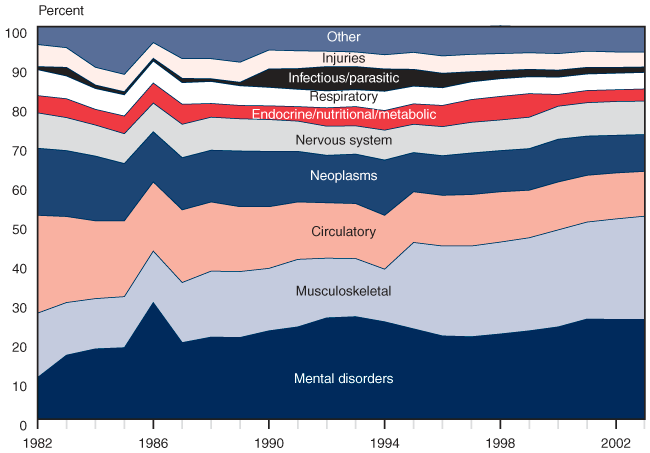
| Year | Mental disorders |
Musculoskeletal | Circulatory | Neoplasms | Nervous system |
Endocrine/ nutritional/ metabolic |
Respiratory | Infectious/ parasitic |
Injuries | Other |
|---|---|---|---|---|---|---|---|---|---|---|
| 1982 | 10.60 | 16.40 | 24.90 | 17.10 | 9.00 | 4.40 | 6.60 | 0.80 | 5.60 | 4.60 |
| 1983 | 16.30 | 13.40 | 21.90 | 16.80 | 8.40 | 4.80 | 5.80 | 2.20 | 5.00 | 5.40 |
| 1984 | 17.90 | 12.80 | 19.80 | 16.50 | 7.90 | 4.00 | 5.30 | 0.90 | 4.50 | 10.40 |
| 1985 | 18.20 | 13.00 | 19.30 | 14.60 | 7.60 | 4.50 | 5.40 | 0.80 | 4.40 | 12.20 |
| 1986 | 29.70 | 13.10 | 17.60 | 12.80 | 7.30 | 5.10 | 5.60 | 0.70 | 4.00 | 4.10 |
| 1987 | 19.50 | 15.30 | 18.50 | 13.30 | 8.50 | 5.10 | 5.50 | 1.10 | 5.00 | 8.20 |
| 1988 | 20.90 | 16.80 | 17.60 | 13.20 | 8.40 | 3.50 | 5.60 | 0.70 | 5.10 | 8.20 |
| 1989 | 20.80 | 16.80 | 16.50 | 14.20 | 8.20 | 3.40 | 5.00 | 0.90 | 5.10 | 9.10 |
| 1990 | 22.50 | 15.90 | 15.70 | 14.10 | 8.10 | 3.50 | 4.70 | 4.70 | 4.80 | 6.00 |
| 1991 | 23.50 | 17.20 | 14.60 | 12.90 | 7.70 | 3.70 | 4.40 | 5.30 | 4.50 | 6.20 |
| 1992 | 25.80 | 15.20 | 14.10 | 12.10 | 7.40 | 4.70 | 4.30 | 6.20 | 3.90 | 6.30 |
| 1993 | 26.10 | 14.80 | 14.00 | 12.60 | 7.20 | 4.90 | 4.30 | 5.90 | 3.70 | 6.50 |
| 1994 | 24.80 | 13.40 | 13.70 | 14.10 | 7.60 | 5.00 | 4.90 | 5.70 | 3.60 | 7.20 |
| 1995 | 23.00 | 22.00 | 12.90 | 10.00 | 7.20 | 5.20 | 4.50 | 4.30 | 4.30 | 6.60 |
| 1996 | 21.20 | 22.90 | 12.90 | 10.10 | 7.40 | 5.40 | 4.50 | 3.70 | 4.40 | 7.50 |
| 1997 | 21.00 | 23.10 | 13.10 | 10.60 | 7.80 | 5.80 | 4.50 | 2.60 | 4.40 | 7.10 |
| 1998 | 21.70 | 23.40 | 12.80 | 10.50 | 7.80 | 6.00 | 4.50 | 2.10 | 4.30 | 7.10 |
| 1999 | 22.50 | 23.70 | 12.10 | 10.60 | 8.00 | 6.00 | 4.30 | 1.90 | 4.20 | 6.70 |
| 2000 | 23.50 | 24.70 | 12.20 | 10.90 | 8.40 | 3.00 | 4.40 | 1.80 | 4.20 | 6.80 |
| 2001 | 25.50 | 24.70 | 11.90 | 10.00 | 8.50 | 3.10 | 4.20 | 1.70 | 4.10 | 6.40 |
| 2002 | 25.40 | 25.60 | 11.70 | 9.60 | 8.60 | 3.00 | 4.20 | 1.50 | 3.90 | 6.60 |
| 2003 | 25.40 | 26.30 | 11.40 | 9.40 | 8.50 | 3.10 | 4.20 | 1.40 | 3.80 | 6.40 |
The number of disabled-worker awards for mental and musculoskeletal impairments has grown substantially since 1982. The large increase in mental disorders in 1986 is directly attributable to changes in the decisionmaking process due to the 1984 Social Security Disability Benefits Reform Act (including mandatory specialist reviews of denials) and the fact that many cases were not adjudicated until new mental regulations were issued in 1986. The changes in 1984 also mandated that SSA revise the way it assesses pain, and after that point musculoskeletal awards began to slowly rise. Other factors may also play a role in the increase in these awards over time, such as an aging population and increases in the number of appeals to administrative law judges.
The percentages of awards represented by mental and musculoskeletal impairments have grown since 1982, while neoplasms and circulatory diseases have declined. Infectious and parasitic diseases show an increase in the late 1980s, which then began to subside in the mid-1990s. HIV/AIDS cases probably accounted for much of this increase, while new or improved treatments and adjustments to policy may have helped reduce the relative prevalence of HIV/AIDS cases among awards in the late 1990s and after.3 Between 1999 and 2000, the percentage of awards represented by nutritional and metabolic diseases dropped by half and thereafter continued at a lower rate. Elimination of the medical listing for obesity in late 1999 may have accounted for this decline.
Entry by SSI Blind and Disabled Adults
Number of awards, by sex
The percentage of awards of SSI payments for disability has been fairly constant for men and women: women aged 18–64 represent roughly half of all awards, varying between 49 percent and just under 53 percent from 1976 to 2003. The small variations by sex show no systematic trend.
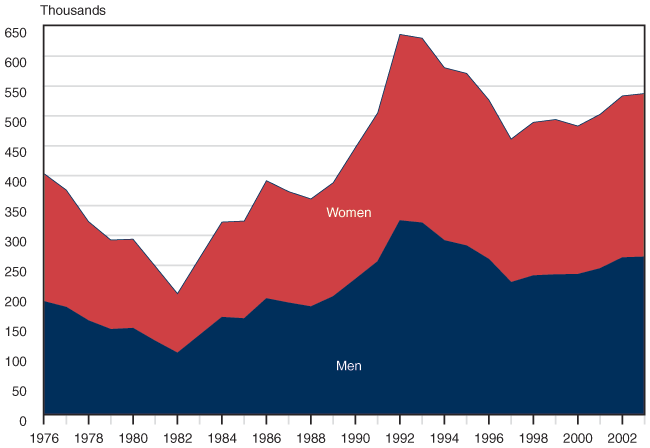
| Year | Men | Women |
|---|---|---|
| 1976 | 189.45 | 213.90 |
| 1977 | 179.89 | 196.06 |
| 1978 | 157.30 | 165.87 |
| 1979 | 142.82 | 149.56 |
| 1980 | 144.72 | 149.02 |
| 1981 | 123.21 | 125.13 |
| 1982 | 103.23 | 99.36 |
| 1983 | 133.14 | 129.52 |
| 1984 | 163.11 | 159.28 |
| 1985 | 160.84 | 163.23 |
| 1986 | 194.35 | 197.25 |
| 1987 | 187.12 | 186.20 |
| 1988 | 180.79 | 180.28 |
| 1989 | 197.75 | 190.37 |
| 1990 | 226.79 | 220.15 |
| 1991 | 256.25 | 248.61 |
| 1992 | 324.78 | 311.52 |
| 1993 | 321.03 | 309.00 |
| 1994 | 291.45 | 289.19 |
| 1995 | 282.69 | 288.39 |
| 1996 | 260.01 | 266.68 |
| 1997 | 221.44 | 239.82 |
| 1998 | 232.67 | 256.57 |
| 1999 | 234.38 | 259.58 |
| 2000 | 234.92 | 248.10 |
| 2001 | 244.57 | 258.02 |
| 2002 | 262.83 | 270.64 |
| 2003 | 264.01 | 273.41 |
The profile of SSI awards to disabled adults changed very little from 1976 to 2003. The percentage of awards to disabled women aged 18–64 has been fairly constant at roughly half of all awards, varying between 49 percent and just under 53 percent during this period. The small variations have no systematic trend. The result is somewhat surprising, since one might expect that fewer women would be awarded SSI payments because of the sharp increase in the number of women awarded disabled-worker benefits during this same period. Given that more women are becoming insured for Disability Insurance and that, in general, they are earning more, the share of SSI for women might be expected to decrease. Other factors may be at play as well.
Percentage distribution of awards, by age at first receipt
Awards of SSI payments to recipients in the middle age groups have increased, which may in part reflect the movement of the baby boomers through the age categories over time.
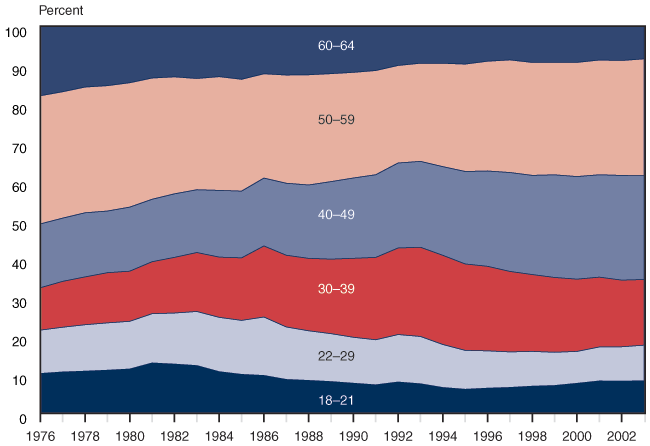
| Year | 18–21 | 22–29 | 30–39 | 40–49 | 50–59 | 60–64 |
|---|---|---|---|---|---|---|
| 1976 | 10.13 | 11.23 | 10.95 | 16.52 | 33.15 | 18.02 |
| 1977 | 10.53 | 11.58 | 11.87 | 16.36 | 32.69 | 16.98 |
| 1978 | 10.73 | 12.02 | 12.37 | 16.60 | 32.52 | 15.77 |
| 1979 | 10.98 | 12.25 | 12.97 | 15.96 | 32.43 | 15.41 |
| 1980 | 11.29 | 12.34 | 12.97 | 16.58 | 32.17 | 14.65 |
| 1981 | 12.85 | 12.75 | 13.44 | 16.16 | 31.36 | 13.43 |
| 1982 | 12.56 | 13.21 | 14.39 | 16.44 | 30.25 | 13.13 |
| 1983 | 12.18 | 14.00 | 15.24 | 16.25 | 28.77 | 13.55 |
| 1984 | 10.59 | 14.06 | 15.58 | 17.27 | 29.41 | 13.08 |
| 1985 | 9.90 | 13.97 | 16.17 | 17.27 | 28.93 | 13.76 |
| 1986 | 9.61 | 15.13 | 18.38 | 17.57 | 26.98 | 12.34 |
| 1987 | 8.59 | 13.59 | 18.55 | 18.63 | 27.99 | 12.66 |
| 1988 | 8.33 | 12.85 | 18.73 | 18.99 | 28.51 | 12.59 |
| 1989 | 8.04 | 12.40 | 19.27 | 20.06 | 27.92 | 12.30 |
| 1990 | 7.61 | 11.90 | 20.42 | 20.78 | 27.32 | 11.97 |
| 1991 | 7.20 | 11.66 | 21.30 | 21.39 | 26.96 | 11.49 |
| 1992 | 7.92 | 12.29 | 22.38 | 21.99 | 25.23 | 10.18 |
| 1993 | 7.46 | 12.25 | 23.07 | 22.22 | 25.38 | 9.61 |
| 1994 | 6.50 | 11.14 | 23.06 | 22.95 | 26.73 | 9.63 |
| 1995 | 6.05 | 10.07 | 22.35 | 23.93 | 27.78 | 9.83 |
| 1996 | 6.33 | 9.66 | 21.86 | 24.66 | 28.39 | 9.09 |
| 1997 | 6.52 | 9.20 | 20.81 | 25.59 | 29.12 | 8.75 |
| 1998 | 6.84 | 9.00 | 19.88 | 25.66 | 29.21 | 9.40 |
| 1999 | 7.02 | 8.61 | 19.34 | 26.55 | 29.12 | 9.35 |
| 2000 | 7.59 | 8.26 | 18.69 | 26.55 | 29.54 | 9.38 |
| 2001 | 8.20 | 8.79 | 18.06 | 26.49 | 29.67 | 8.78 |
| 2002 | 8.14 | 8.91 | 17.24 | 27.09 | 29.73 | 8.90 |
| 2003 | 8.25 | 9.21 | 16.98 | 26.86 | 30.22 | 8.48 |
As can be observed in the chart, new awards to recipients in the age group 40–49 increased over the entire period. Awards to persons aged 30–39 also increased, but that growth moderated in the mid-1990s. The changing age profile for SSI blind and disabled adults is similar to that observed in the DI worker program. Given the timing and size of the increases in the 30–39 and 40–49 age groups, at least part of this age shift may be demographic, though the changing diagnostic profile may also play a role.
Entry by Blind and Disabled Adults
Percentage distribution of awards, by diagnostic group
The proportion of SSI awards based on mental disorders (other than mental retardation) and musculoskeletal diseases among all SSI awards has increased over time, while the proportion based on mental retardation has declined.
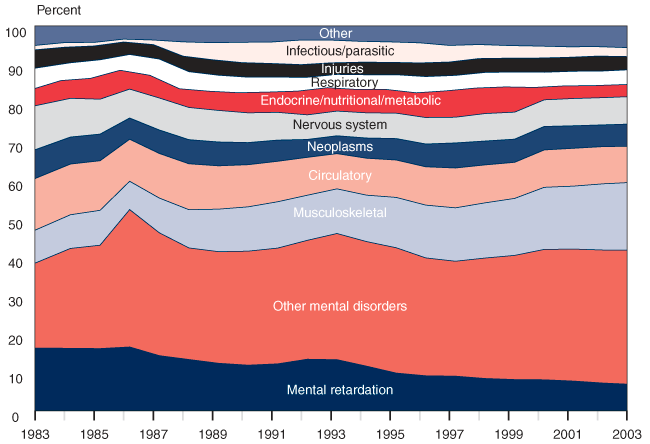
| Year | Mental retardation |
Other mental disorders |
Musculoskeletal | Circulatory | Neoplasms | Nervous system |
Endocrine/ nutritional/ metabolic |
Respiratory | Injuries | Infectious/ parasitic |
Other |
|---|---|---|---|---|---|---|---|---|---|---|---|
| 1983 | 16.31 | 22.05 | 8.56 | 13.42 | 7.48 | 11.43 | 4.51 | 5.27 | 4.77 | 1.14 | 5.06 |
| 1984 | 16.25 | 25.95 | 8.75 | 13.17 | 7.03 | 10.05 | 4.62 | 4.62 | 4.05 | 1.19 | 4.32 |
| 1985 | 16.19 | 26.85 | 9.07 | 12.87 | 6.93 | 9.07 | 5.41 | 4.82 | 3.60 | 0.92 | 4.27 |
| 1986 | 16.60 | 35.70 | 7.36 | 10.91 | 5.53 | 7.51 | 4.89 | 4.11 | 3.24 | 0.74 | 3.42 |
| 1987 | 14.34 | 31.93 | 9.03 | 11.58 | 6.11 | 8.31 | 5.90 | 4.21 | 3.75 | 1.18 | 3.65 |
| 1988 | 13.34 | 28.99 | 9.94 | 11.91 | 6.28 | 8.36 | 4.87 | 4.42 | 4.05 | 3.69 | 4.14 |
| 1989 | 12.36 | 29.00 | 11.04 | 11.25 | 6.21 | 8.19 | 4.99 | 4.15 | 4.03 | 4.42 | 4.35 |
| 1990 | 11.87 | 29.62 | 11.52 | 10.94 | 5.76 | 7.71 | 5.24 | 4.02 | 3.79 | 5.28 | 4.24 |
| 1991 | 12.22 | 30.08 | 12.04 | 10.51 | 5.52 | 7.20 | 5.28 | 3.85 | 3.57 | 5.57 | 4.17 |
| 1992 | 13.41 | 30.89 | 11.72 | 9.84 | 4.67 | 6.38 | 6.17 | 3.59 | 3.30 | 6.38 | 3.65 |
| 1993 | 13.30 | 32.78 | 11.60 | 9.14 | 4.66 | 6.41 | 6.08 | 3.44 | 3.02 | 5.89 | 3.68 |
| 1994 | 11.61 | 32.37 | 12.07 | 9.59 | 5.27 | 6.53 | 6.08 | 3.81 | 3.27 | 5.41 | 4.00 |
| 1995 | 9.82 | 32.56 | 13.08 | 9.71 | 5.59 | 6.59 | 6.15 | 3.83 | 3.24 | 5.29 | 4.15 |
| 1996 | 9.12 | 30.62 | 13.72 | 9.94 | 5.94 | 6.87 | 6.43 | 4.21 | 3.56 | 5.21 | 4.38 |
| 1997 | 9.01 | 29.86 | 13.88 | 10.34 | 6.53 | 6.67 | 6.85 | 4.02 | 3.49 | 4.30 | 5.05 |
| 1998 | 8.41 | 31.29 | 14.34 | 9.85 | 6.22 | 7.13 | 6.63 | 4.05 | 3.62 | 3.62 | 4.83 |
| 1999 | 8.14 | 32.25 | 14.81 | 9.37 | 6.03 | 7.01 | 6.56 | 3.87 | 3.60 | 3.27 | 5.09 |
| 2000 | 8.08 | 33.87 | 16.13 | 9.71 | 6.11 | 6.92 | 3.23 | 3.94 | 3.70 | 3.10 | 5.23 |
| 2001 | 7.73 | 34.30 | 16.37 | 9.82 | 5.87 | 7.08 | 3.27 | 3.80 | 3.63 | 2.73 | 5.40 |
| 2002 | 7.22 | 34.57 | 17.21 | 9.66 | 5.66 | 7.06 | 3.13 | 3.79 | 3.87 | 2.44 | 5.38 |
| 2003 | 6.94 | 34.80 | 17.55 | 9.42 | 5.78 | 7.12 | 3.18 | 3.79 | 3.47 | 2.30 | 5.63 |
There are clear trends showing increasing SSI awards for mental disorders (other than mental retardation) and for musculoskeletal diseases. The same increases were found for awards to disabled workers. Adult SSI awards for mental retardation have declined both in number and as a percentage of awards during most of the 1983–2003 period. As was true with awards to disabled workers, the percentage of SSI awards for circulatory diseases declined from 1983 to 2003, and the increase in the number and percentage of awards for infectious and parasitic diseases (mostly HIV/AIDS) that began in the late 1980s moderated somewhat in the mid-1990s.4
Entry by SSI Disabled Children
Number of awards, by sex
From 1976 to 2003, the percentage of males being awarded SSI children's benefits increased from 57 percent to nearly 65 percent. There was a large increase in the proportion of awards to males after the Zebley decision in 1990.
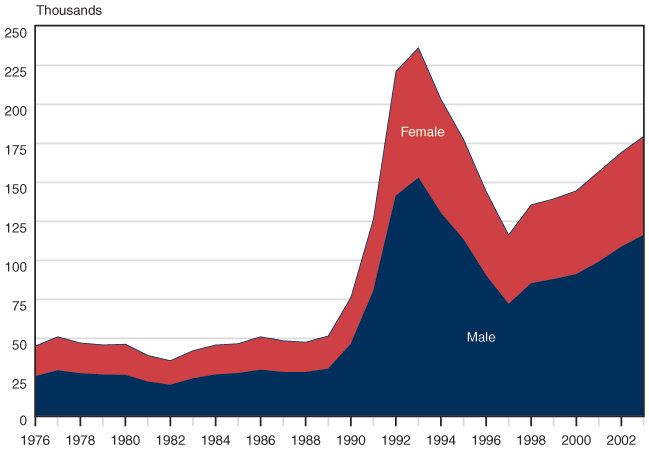
| Year | Male | Female |
|---|---|---|
| 1976 | 25.57 | 19.46 |
| 1977 | 29.31 | 21.66 |
| 1978 | 27.46 | 19.59 |
| 1979 | 26.66 | 19.15 |
| 1980 | 26.41 | 19.85 |
| 1981 | 22.12 | 16.93 |
| 1982 | 20.06 | 15.61 |
| 1983 | 24.20 | 17.91 |
| 1984 | 26.67 | 19.07 |
| 1985 | 27.56 | 19.03 |
| 1986 | 29.71 | 21.31 |
| 1987 | 28.22 | 20.26 |
| 1988 | 28.24 | 19.32 |
| 1989 | 30.40 | 21.12 |
| 1990 | 46.16 | 29.91 |
| 1991 | 80.08 | 46.11 |
| 1992 | 141.25 | 79.83 |
| 1993 | 152.69 | 83.53 |
| 1994 | 130.07 | 73.12 |
| 1995 | 113.16 | 64.39 |
| 1996 | 90.11 | 54.16 |
| 1997 | 71.78 | 44.50 |
| 1998 | 85.14 | 50.46 |
| 1999 | 87.83 | 51.57 |
| 2000 | 90.96 | 53.58 |
| 2001 | 98.91 | 57.99 |
| 2002 | 108.54 | 60.59 |
| 2003 | 116.19 | 63.40 |
The category of SSI disabled children has seen changes to its profile of awards over time. Awards to males have historically outnumbered awards to females, and there has been a substantial increase in awards to males over the period 1976 to 2003. In 2003, there were nearly twice as many awards to males as to females. The percentage of awards to males increased dramatically after the Zebley decision in 1990, rising to nearly 65 percent in 1993. The percentage of males awarded benefits declined from 1993 until 1997 and has been increasing since. In 2003, the percentage of males was again nearing 65 percent and reached a historical high.
Percentage distribution of awards, by age
In the early 1990s following the Zebley decision, the percentage of awards going to children in the older age groups increased for a time, particularly in the age group 5–12. In 1992 the percentage of awards to children under the age of 5 began to increase; however, since 1997, it has been decreasing.
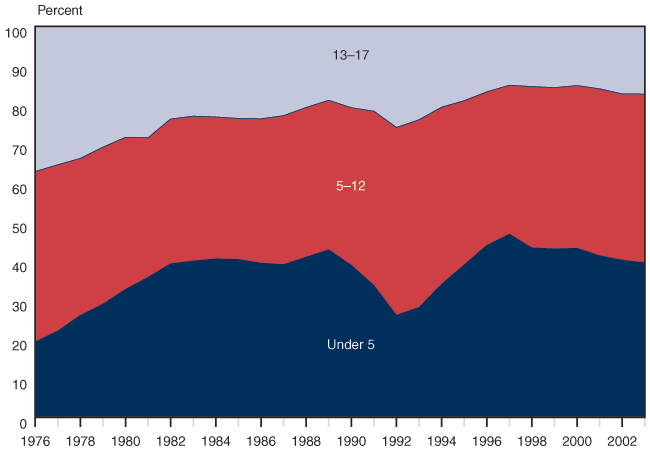
| Year | Under 5 | 5–12 | 13–17 |
|---|---|---|---|
| 1976 | 19.30 | 43.59 | 37.11 |
| 1977 | 22.09 | 42.52 | 35.39 |
| 1978 | 26.08 | 40.15 | 33.77 |
| 1979 | 28.95 | 40.17 | 30.89 |
| 1980 | 32.75 | 38.89 | 28.36 |
| 1981 | 35.83 | 35.70 | 28.48 |
| 1982 | 39.28 | 37.03 | 23.69 |
| 1983 | 40.01 | 37.02 | 22.96 |
| 1984 | 40.53 | 36.29 | 23.17 |
| 1985 | 40.39 | 36.06 | 23.55 |
| 1986 | 39.46 | 36.91 | 23.64 |
| 1987 | 39.09 | 38.08 | 22.83 |
| 1988 | 40.98 | 38.29 | 20.73 |
| 1989 | 42.86 | 38.24 | 18.91 |
| 1990 | 38.90 | 40.30 | 20.80 |
| 1991 | 33.73 | 44.58 | 21.69 |
| 1992 | 26.12 | 48.02 | 25.86 |
| 1993 | 28.11 | 48.01 | 23.88 |
| 1994 | 34.05 | 45.28 | 20.67 |
| 1995 | 38.98 | 42.02 | 19.00 |
| 1996 | 43.97 | 39.28 | 16.75 |
| 1997 | 46.86 | 38.09 | 15.05 |
| 1998 | 43.34 | 41.27 | 15.39 |
| 1999 | 43.09 | 41.25 | 15.66 |
| 2000 | 43.24 | 41.63 | 15.13 |
| 2001 | 41.34 | 42.69 | 15.97 |
| 2002 | 40.22 | 42.52 | 17.26 |
| 2003 | 39.54 | 43.16 | 17.30 |
The Zebley decision in 1990 led to a large but temporary increase in the percentage of awards for children aged 5–12 and, to a lesser extent, for those aged 13–17. The proportion of awards to children 13 and older has shown slight increases since 1997, reversing the trend of significant decreases in the late 1970s and 1980s. The percentage of awards to children aged 5–12 increased dramatically after Zebley and began to decline even before the implementation in 1996 of statutorily mandated changes to the children's criteria, which altered the way that SSA assessed behavioral problems. Since 1997, both the number and percentage of awards to children aged 5–12 have been increasing modestly. With the exception of the temporary increase in other age groups mentioned above, the percentage of SSI disabled child awards to children under the age of 5 generally increased until it reached a peak in 1997 and has decreased slightly since then. The increase in awards to children under 5 that began in 1993 is due, in part, to SSA regulations issued in 1991 that made low birth weight functionally equivalent to meeting a medical listing.5 The number of awards based on low birth weight in this age group has continued to increase, despite the trend toward a smaller proportion of awards for children under 5.
Percentage distribution of awards, by diagnostic group
Significant changes in the distribution of diagnoses have occurred among awards to SSI disabled children. The percentage of awards due to mental retardation has been declining since the mid-1980s, while the percentage of awards for other mental disorders has increased dramatically. Nervous system impairments declined as a percentage of awards throughout the 1980s into the early 1990s, while awards for 'low birth weight' increased after 1992.
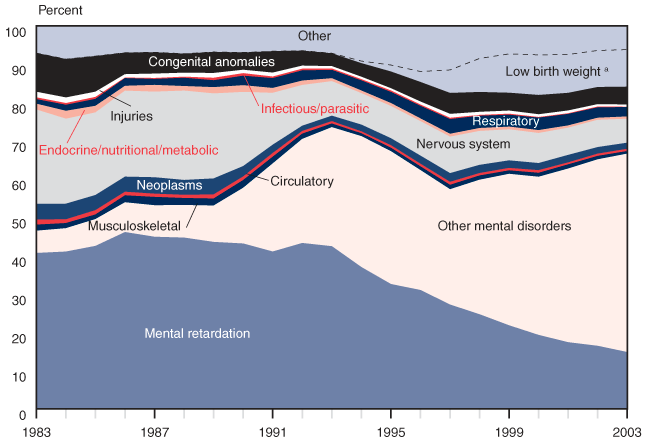
| Year | Mental retardation |
Other mental disorders |
Musculoskeletal | Circulatory | Neoplasms | Nervous system |
Endocrine/ nutritional/ metabolic |
Respiratory | Infectious/ parasitic |
Injuries | Congenital anomalies |
Low birth weight a |
Other |
|---|---|---|---|---|---|---|---|---|---|---|---|---|---|
| 1983 | 40.70 | 5.81 | 1.58 | 1.34 | 4.08 | 24.63 | 1.53 | 1.18 | 0.47 | 1.45 | 10.13 | 0.00 | 7.10 |
| 1984 | 41.07 | 6.10 | 1.34 | 0.97 | 4.10 | 22.17 | 2.07 | 1.57 | 0.46 | 1.45 | 10.04 | 0.00 | 8.67 |
| 1985 | 42.55 | 7.00 | 1.20 | 1.11 | 3.97 | 21.55 | 1.74 | 1.81 | 0.51 | 1.36 | 9.32 | 0.00 | 7.89 |
| 1986 | 46.16 | 7.77 | 1.82 | 0.93 | 3.96 | 22.44 | 1.27 | 2.00 | 0.16 | 0.87 | 5.63 | 0.00 | 7.00 |
| 1987 | 44.93 | 8.23 | 2.17 | 0.84 | 4.30 | 22.35 | 1.76 | 1.55 | 0.26 | 1.14 | 5.59 | 0.00 | 6.90 |
| 1988 | 44.71 | 8.50 | 1.83 | 0.81 | 3.90 | 23.33 | 1.19 | 2.16 | 0.29 | 1.04 | 4.98 | 0.00 | 7.27 |
| 1989 | 43.58 | 9.50 | 1.83 | 1.06 | 4.19 | 22.19 | 1.65 | 1.79 | 0.65 | 1.24 | 5.51 | 0.00 | 6.81 |
| 1990 | 43.17 | 14.53 | 2.02 | 0.92 | 2.73 | 19.35 | 1.76 | 2.47 | 0.67 | 0.88 | 4.53 | 0.00 | 6.95 |
| 1991 | 41.07 | 22.99 | 1.74 | 0.96 | 2.19 | 13.54 | 1.27 | 2.57 | 0.42 | 1.01 | 5.60 | 0.01 | 6.62 |
| 1992 | 43.30 | 27.17 | 1.37 | 0.68 | 1.39 | 10.64 | 1.16 | 2.65 | 0.45 | 0.79 | 3.92 | 0.01 | 6.46 |
| 1993 | 42.46 | 31.07 | 0.96 | 0.59 | 1.44 | 9.02 | 0.77 | 2.17 | 0.37 | 0.61 | 3.37 | 0.03 | 7.14 |
| 1994 | 37.01 | 34.18 | 0.75 | 0.48 | 1.78 | 8.21 | 0.69 | 2.63 | 0.34 | 0.61 | 3.56 | 0.57 | 9.19 |
| 1995 | 32.59 | 34.67 | 0.90 | 0.64 | 1.85 | 8.40 | 0.78 | 2.88 | 0.40 | 0.57 | 4.37 | 1.72 | 10.22 |
| 1996 | 31.03 | 31.29 | 0.96 | 0.69 | 2.13 | 8.99 | 0.73 | 3.27 | 0.35 | 0.77 | 5.12 | 2.76 | 11.91 |
| 1997 | 27.23 | 30.10 | 1.15 | 0.76 | 2.29 | 9.52 | 0.76 | 3.83 | 0.35 | 1.01 | 5.48 | 6.02 | 11.50 |
| 1998 | 24.70 | 35.12 | 1.10 | 0.63 | 2.15 | 8.85 | 0.77 | 3.20 | 0.22 | 0.79 | 5.20 | 8.77 | 8.51 |
| 1999 | 21.81 | 39.55 | 0.90 | 0.63 | 1.99 | 8.11 | 0.70 | 3.10 | 0.27 | 0.81 | 4.67 | 10.16 | 7.31 |
| 2000 | 19.30 | 41.30 | 1.02 | 0.68 | 1.87 | 7.84 | 0.77 | 3.24 | 0.18 | 0.70 | 5.05 | 10.48 | 7.57 |
| 2001 | 17.40 | 45.33 | 1.08 | 0.51 | 1.97 | 7.10 | 0.60 | 2.99 | 0.18 | 0.72 | 4.61 | 10.03 | 7.47 |
| 2002 | 16.46 | 48.68 | 0.89 | 0.58 | 1.73 | 7.12 | 0.55 | 2.71 | 0.21 | 0.61 | 4.49 | 9.56 | 6.42 |
| 2003 | 14.84 | 51.80 | 0.67 | 0.57 | 1.61 | 6.25 | 0.61 | 2.44 | 0.10 | 0.56 | 4.67 | 9.69 | 6.20 |
Very significant changes have occurred in the distribution of diagnoses among awards to SSI disabled children. The percentage of awards based on mental retardation has been declining since the mid-1980s, while the percentage of awards for other mental disorders has increased dramatically. The increase in the percentage of awards based on other mental disorders is likely due to several factors: the 1984 Amendments and revised mental listings; the Zebley case in 1990 that resulted in increased awards for mental disorders that cause behavioral problems; and a change to more precise diagnostic coding for children with certain cognitive limitations, that is, a change in the diagnostic coding of "borderline mental retardation" from the "Mental retardation" diagnostic group to the "Other mental disorders" group. The change in diagnostic coding cannot account for the entire reduction in the diagnoses for mental retardation, however, since the decline began before 1993.
"Nervous system" diseases declined as a percentage of awards throughout the 1980s into the early 1990s, while the percentage of awards for "Other" disorders increased considerably after 1993. The increase in awards for "Other" and "Low birth weight" are due, in part, to Zebley-related changes. After the Zebley decision, SSA instituted a policy in which low birth weight was considered functionally equivalent to meeting a medical listing.
Exit by Social Security Disabled Beneficiaries
Number and rate of terminations
The number of terminations from the Social Security disability program has generally been increasing since the mid-1980s. The rate of termination of disabled workers declined from 1982 until 1996, and, with the exception of 1997 and terminations for drug addiction and alcoholism, the rate was fairly stable until 2002.
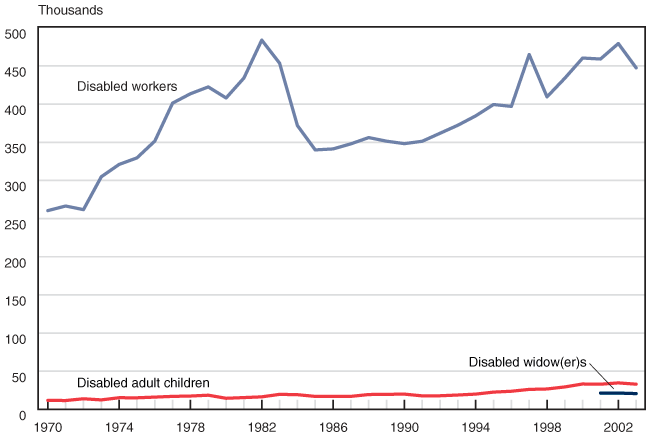
| Year | Disabled workers |
Disabled adult children |
Disabled widow(er)s |
|---|---|---|---|
| 1970 | 260.44 | 11.80 | -- |
| 1971 | 266.47 | 11.62 | -- |
| 1972 | 261.74 | 13.92 | -- |
| 1973 | 304.79 | 12.45 | -- |
| 1974 | 320.96 | 15.29 | -- |
| 1975 | 329.53 | 15.20 | -- |
| 1976 | 351.50 | 16.10 | -- |
| 1977 | 401.33 | 17.06 | -- |
| 1978 | 413.57 | 17.50 | -- |
| 1979 | 422.50 | 18.60 | -- |
| 1980 | 408.05 | 14.56 | -- |
| 1981 | 434.19 | 15.48 | -- |
| 1982 | 483.85 | 16.44 | -- |
| 1983 | 453.62 | 19.71 | -- |
| 1984 | 371.91 | 19.28 | -- |
| 1985 | 339.98 | 17.02 | -- |
| 1986 | 341.28 | 17.01 | -- |
| 1987 | 347.95 | 17.06 | -- |
| 1988 | 356.14 | 19.48 | -- |
| 1989 | 351.40 | 19.73 | -- |
| 1990 | 348.19 | 20.01 | -- |
| 1991 | 351.30 | 17.72 | -- |
| 1992 | 361.80 | 17.86 | -- |
| 1993 | 372.32 | 18.84 | -- |
| 1994 | 384.59 | 20.03 | -- |
| 1995 | 399.48 | 22.64 | -- |
| 1996 | 396.98 | 23.78 | -- |
| 1997 | 464.98 | 26.21 | -- |
| 1998 | 409.49 | 26.76 | -- |
| 1999 | 433.95 | 29.44 | -- |
| 2000 | 460.35 | 33.30 | -- |
| 2001 | 459.07 | 32.99 | 21.41 |
| 2002 | 479.36 | 34.72 | 21.38 |
| 2003 | 447.49 | 33.03 | 20.71 |
| NOTE: -- = not available. | |||
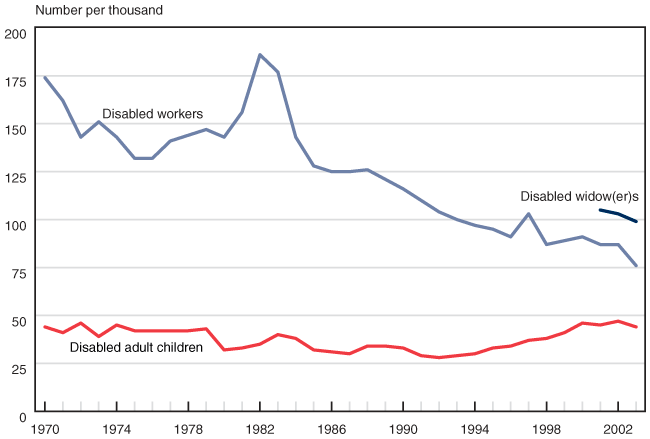
| Year | Disabled workers |
Disabled adult children |
Disabled widow(er)s |
|---|---|---|---|
| 1970 | 174 | 44 | -- |
| 1971 | 162 | 41 | -- |
| 1972 | 143 | 46 | -- |
| 1973 | 151 | 39 | -- |
| 1974 | 143 | 45 | -- |
| 1975 | 132 | 42 | -- |
| 1976 | 132 | 42 | -- |
| 1977 | 141 | 42 | -- |
| 1978 | 144 | 42 | -- |
| 1979 | 147 | 43 | -- |
| 1980 | 143 | 32 | -- |
| 1981 | 156 | 33 | -- |
| 1982 | 186 | 35 | -- |
| 1983 | 177 | 40 | -- |
| 1984 | 143 | 38 | -- |
| 1985 | 128 | 32 | -- |
| 1986 | 125 | 31 | -- |
| 1987 | 125 | 30 | -- |
| 1988 | 126 | 34 | -- |
| 1989 | 121 | 34 | -- |
| 1990 | 116 | 33 | -- |
| 1991 | 110 | 29 | -- |
| 1992 | 104 | 28 | -- |
| 1993 | 100 | 29 | -- |
| 1994 | 97 | 30 | -- |
| 1995 | 95 | 33 | -- |
| 1996 | 91 | 34 | -- |
| 1997 | 103 | 37 | -- |
| 1998 | 87 | 38 | -- |
| 1999 | 89 | 41 | -- |
| 2000 | 91 | 46 | -- |
| 2001 | 87 | 45 | 105 |
| 2002 | 87 | 47 | 103 |
| 2003 | 76 | 44 | 99 |
| NOTE: -- = not available. | |||
The number of terminations of disabled workers rose fairly consistently from 1970 to 1982, after which terminations began to decline because of reductions in the processing of continuing disability reviews by some states. This was followed by a nationwide moratorium on continuing disability reviews in April 1984 and the medical improvement review standard that was enacted in 1984.6 The number of terminations began to rise again in 1986 and grew consistently with two exceptions: a large and temporary increase in 1997 that resulted from welfare reform legislation that ended entitlement to benefits based on drug addiction and alcoholism; and a decline in the number of terminations in 2003. The legislated increase in the full retirement age that took place for workers attaining age 62 in 2000, and the resulting decrease in retirement conversions, would account for much of this decline in 2003.7 The number of terminations of disabled adult children has varied but increased overall during the 1970–2003 period.
Despite the general pattern of increasing numbers of terminations in the Social Security disability program, terminations have not kept pace with the number of disability awards, and the program has grown. The rate of termination per 1,000 disabled-worker beneficiaries declined nearly every year between 1982 and 1996. Although part of this decline is likely due to the medical improvement review standard enacted in 1984, it is also likely that increased awards of benefits to younger persons based on mental disorders contributed to this result. The brief increase in the rate of terminations of disabled workers in 1997 was due, at least in part, to the change in the drug addiction and alcoholism policy and the dedicated funding for continuing disability reviews that began in 1996 as part of P.L. 104-121.
Between 1998 and 2000, the rate of termination of disabled workers remained relatively stable at historically low rates, despite the dedicated CDR funding that was in place from 1996 to 2002. In 2003, the first increase in the full retirement age reduced the rate of termination for disabled workers. Although the termination rate of disabled adult children dipped in 1980 and again in 1991, it has been increasing since then. Termination rates for disabled workers and disabled adult children have been converging since the early 1990s, although the rate for workers remains nearly twice that of adult children. Chart 35 shows that, from the limited data available, the termination rate for disabled widow(er)s is higher than that for disabled workers. This higher termination rate may be due to the fact that widow(er)s are not eligible for benefits until they are 50 and are consequently closer to a conversion to Social Security (OASI) widow(er)'s benefits.
Exit by Disabled Workers
Number and rate of terminations, by reason
The result of changes in policy concerning drug addiction and alcoholism is evident in the large, temporary increase in recoveries in 1997. The overall rate of termination decreased consistently until the 1-year rise in 1997 resulting from terminations of benefits for drug addiction and alcoholism.
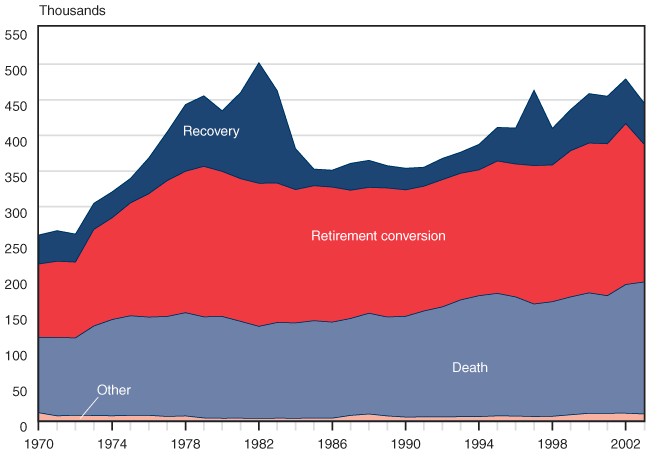
| Year | Other | Death | Retirement conversion |
Recovery |
|---|---|---|---|---|
| 1970 | 10.93 | 105.80 | 102.92 | 40.80 |
| 1971 | 6.59 | 109.88 | 107.02 | 42.98 |
| 1972 | 7.41 | 108.66 | 106.27 | 39.39 |
| 1973 | 7.07 | 125.58 | 135.45 | 36.70 |
| 1974 | 6.68 | 135.08 | 142.72 | 36.48 |
| 1975 | 7.26 | 139.81 | 158.30 | 34.39 |
| 1976 | 7.30 | 137.89 | 173.06 | 50.36 |
| 1977 | 5.75 | 140.34 | 190.51 | 68.31 |
| 1978 | 6.47 | 144.88 | 198.36 | 93.67 |
| 1979 | 3.62 | 141.92 | 211.04 | 99.11 |
| 1980 | 3.24 | 142.80 | 203.47 | 85.13 |
| 1981 | 3.31 | 135.92 | 200.08 | 120.83 |
| 1982 | 2.93 | 129.29 | 200.67 | 169.20 |
| 1983 | 3.32 | 134.28 | 195.51 | 129.78 |
| 1984 | 3.19 | 133.86 | 186.96 | 57.55 |
| 1985 | 3.40 | 136.71 | 189.32 | 23.45 |
| 1986 | 3.39 | 134.78 | 189.33 | 23.88 |
| 1987 | 7.22 | 136.06 | 179.82 | 37.83 |
| 1988 | 9.16 | 141.38 | 176.57 | 38.00 |
| 1989 | 6.46 | 138.87 | 180.90 | 31.40 |
| 1990 | 4.90 | 141.41 | 177.33 | 30.44 |
| 1991 | 5.11 | 148.69 | 174.97 | 26.71 |
| 1992 | 5.11 | 154.40 | 178.45 | 29.85 |
| 1993 | 5.44 | 163.84 | 177.62 | 29.67 |
| 1994 | 5.55 | 169.67 | 176.43 | 35.92 |
| 1995 | 6.57 | 171.87 | 185.64 | 47.28 |
| 1996 | 6.33 | 167.15 | 186.43 | 50.57 |
| 1997 | 5.60 | 157.95 | 194.16 | 105.96 |
| 1998 | 5.97 | 160.82 | 191.73 | 51.53 |
| 1999 | 8.12 | 165.43 | 205.08 | 57.80 |
| 2000 | 10.18 | 169.00 | 210.07 | 69.48 |
| 2001 | 10.26 | 164.97 | 213.12 | 66.78 |
| 2002 | 10.30 | 180.60 | 225.67 | 62.79 |
| 2003 | 9.22 | 185.21 | 193.31 | 58.01 |
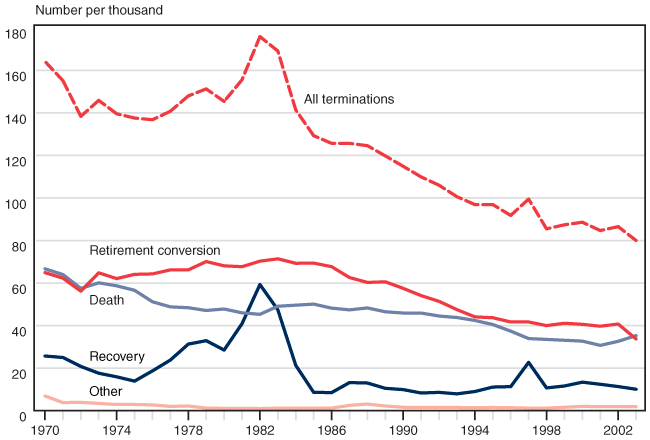
| Year | All terminations | Retirement conversion | Death | Recovery | Other |
|---|---|---|---|---|---|
| 1970 | 164.20 | 64.90 | 66.70 | 25.70 | 6.90 |
| 1971 | 155.20 | 62.30 | 64.00 | 25.00 | 3.80 |
| 1972 | 138.40 | 56.20 | 57.50 | 20.80 | 3.90 |
| 1973 | 145.90 | 64.80 | 60.10 | 17.60 | 3.40 |
| 1974 | 139.60 | 62.10 | 58.70 | 15.90 | 2.90 |
| 1975 | 137.60 | 64.10 | 56.60 | 13.90 | 2.90 |
| 1976 | 136.80 | 64.30 | 51.20 | 18.70 | 2.70 |
| 1977 | 140.80 | 66.20 | 48.80 | 23.80 | 2.00 |
| 1978 | 148.00 | 66.20 | 48.40 | 31.30 | 2.20 |
| 1979 | 151.30 | 70.10 | 47.10 | 32.90 | 1.20 |
| 1980 | 145.40 | 68.10 | 47.80 | 28.50 | 1.10 |
| 1981 | 155.60 | 67.70 | 46.00 | 40.90 | 1.10 |
| 1982 | 175.90 | 70.30 | 45.30 | 59.30 | 1.00 |
| 1983 | 169.10 | 71.40 | 49.10 | 47.40 | 1.20 |
| 1984 | 141.40 | 69.30 | 49.60 | 21.30 | 1.20 |
| 1985 | 129.30 | 69.40 | 50.10 | 8.60 | 1.20 |
| 1986 | 125.70 | 67.70 | 48.20 | 8.50 | 1.20 |
| 1987 | 125.70 | 62.60 | 47.40 | 13.20 | 2.50 |
| 1988 | 124.60 | 60.30 | 48.30 | 13.00 | 3.10 |
| 1989 | 119.80 | 60.60 | 46.50 | 10.50 | 2.20 |
| 1990 | 114.90 | 57.50 | 45.90 | 9.90 | 1.60 |
| 1991 | 109.90 | 54.10 | 45.90 | 8.30 | 1.60 |
| 1992 | 106.00 | 51.40 | 44.50 | 8.60 | 1.50 |
| 1993 | 100.60 | 47.50 | 43.80 | 7.90 | 1.50 |
| 1994 | 96.90 | 44.10 | 42.40 | 9.00 | 1.40 |
| 1995 | 96.90 | 43.70 | 40.50 | 11.10 | 1.50 |
| 1996 | 91.80 | 41.70 | 37.40 | 11.30 | 1.40 |
| 1997 | 99.50 | 41.70 | 33.90 | 22.70 | 1.20 |
| 1998 | 85.50 | 40.00 | 33.50 | 10.70 | 1.20 |
| 1999 | 87.40 | 41.10 | 33.10 | 11.60 | 1.60 |
| 2000 | 88.60 | 40.60 | 32.70 | 13.40 | 2.00 |
| 2001 | 84.70 | 39.70 | 30.70 | 12.40 | 1.90 |
| 2002 | 86.53 | 40.74 | 32.60 | 11.33 | 1.86 |
| 2003 | 80.01 | 33.71 | 35.28 | 10.07 | 1.85 |
Terminations of disabled-worker beneficiaries peaked in 1982 (both in number and as a rate), driven mostly by recovery terminations as a result of accelerated CDRs.8 After dropping off dramatically, the number of recoveries (which includes medical improvement and terminations for substantial gainful activity, or SGA) has increased since the mid-1980s (Chart 36). The result of changes in drug addiction and alcoholism policy is evident in the large, temporary increase in recoveries in 1997.
Although the number of terminations of disabled workers has generally been rising since the mid-1980s, the overall (or total) rate of terminations decreased consistently until the 1-year rise in 1997, which was the result of terminations for drug addiction and alcoholism (Chart 37). The rate has been relatively stable since then.
The rate of termination for recovery (medical improvement and earnings above the SGA level) generally increased from the early 1990s until 2000, then began to decline. Special funding of continuing disability reviews in recent years may have helped increase terminations for medical recovery.
Terminations due to death and conversion to retirement (old-age) benefits have been declining, reflecting the changing age profile of the beneficiary population, which was discussed earlier. The decline in old-age conversions in 2003 is the result, in part, of the delay of conversions because of the increases in the retirement age that are being phased in.
Exit by SSI Blind and Disabled Adults and Children
Number and rate of terminations
The number of terminations of SSI payments rose fairly consistently for blind and disabled adults and children until 1997. Since then the number of terminations has varied at levels slightly lower than those attained in 1997. The rate of terminations of disabled adult SSI recipients remained fairly constant from 1980 to 2003, while the rate of terminations of disabled child recipients has fluctuated greatly.
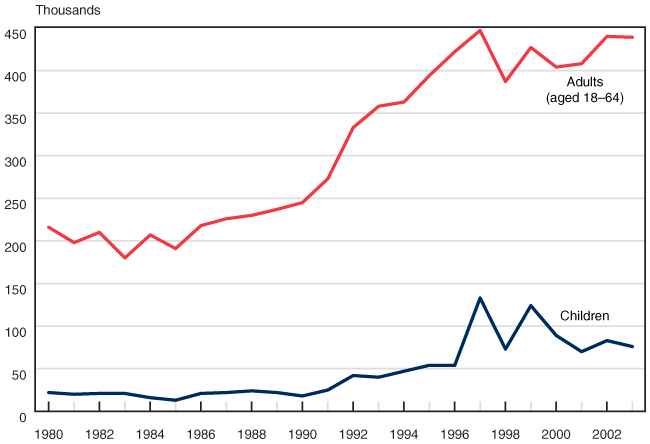
| Year | Children | Adults (aged 18–64) |
|---|---|---|
| 1980 | 22 | 216 |
| 1981 | 20 | 198 |
| 1982 | 21 | 210 |
| 1983 | 21 | 180 |
| 1984 | 16 | 207 |
| 1985 | 13 | 191 |
| 1986 | 21 | 218 |
| 1987 | 22 | 226 |
| 1988 | 24 | 230 |
| 1989 | 22 | 237 |
| 1990 | 18 | 245 |
| 1991 | 25 | 273 |
| 1992 | 42 | 333 |
| 1993 | 40 | 358 |
| 1994 | 47 | 363 |
| 1995 | 54 | 394 |
| 1996 | 54 | 422 |
| 1997 | 133 | 447 |
| 1998 | 73 | 387 |
| 1999 | 124 | 427 |
| 2000 | 89 | 404 |
| 2001 | 70 | 408 |
| 2002 | 83 | 440 |
| 2003 | 76 | 439 |
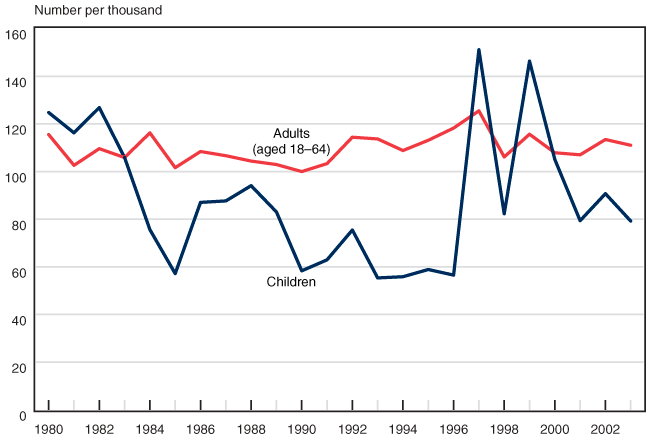
| Year | Children | Adults (aged 18–64) |
|---|---|---|
| 1980 | 115.55 | 124.79 |
| 1981 | 102.62 | 116.27 |
| 1982 | 109.62 | 126.87 |
| 1983 | 105.89 | 105.90 |
| 1984 | 75.62 | 116.26 |
| 1985 | 57.17 | 101.64 |
| 1986 | 87.07 | 108.43 |
| 1987 | 87.68 | 106.67 |
| 1988 | 94.07 | 104.42 |
| 1989 | 83.05 | 102.96 |
| 1990 | 58.33 | 100.00 |
| 1991 | 62.95 | 103.35 |
| 1992 | 75.48 | 114.43 |
| 1993 | 55.35 | 113.71 |
| 1994 | 55.85 | 108.84 |
| 1995 | 58.88 | 113.15 |
| 1996 | 56.53 | 118.26 |
| 1997 | 151.17 | 125.50 |
| 1998 | 82.29 | 106.14 |
| 1999 | 146.39 | 115.69 |
| 2000 | 105.10 | 107.91 |
| 2001 | 79.38 | 107.04 |
| 2002 | 90.73 | 113.47 |
| 2003 | 79.22 | 111.05 |
The number of terminations of blind and disabled adult SSI recipients (aged 18–64) generally increased between 1980 and 1997 and, despite some reductions in the late 1990s, has roughly doubled. The moratorium in 1984 on continuing disability reviews (and earlier state actions) seems to have had little impact on the number of SSI terminations, although the rate of terminations for SSI disabled children may have been affected. After reaching a peak in 1997, in part because of the 1996 changes that terminated payments based on drug addiction and alcoholism and altered SSI policy toward children, SSI terminations decreased; however, for SSI adults, terminations are once again approaching the 1997 level.
The rate of terminations for blind and disabled adult SSI recipients has been relatively consistent from 1980 to 2003, varying modestly but staying within the range of 100 to 120 per thousand, except in 1997. In contrast, the rate of terminations for SSI disabled children has witnessed large fluctuations, with the rate falling below 60 per thousand and rising to 150 per thousand. The large decline between 1982 and 1985 probably reflects the moratorium on continuing disability reviews and earlier state actions. The peaks in 1997 and 1999 reflect the childhood redeterminations mandated by welfare reform legislation in 1996 (and the administrative reviews of those redeterminations that followed). The mandated redeterminations of SSI children attaining the age of 18 and reviews by the first birthday of children with low birth weight (P.L. 104-193) have also contributed to the higher rate of terminations of SSI disabled children since 1997. Before 1996, few continuing disability reviews were conducted on SSI disabled recipients. In 1994, Congress mandated that continuing disability reviews be conducted on a minimum of 100,000 SSI recipients a year between 1996 and 1998 (P.L. 103-296). In 1996, Congress provided special dedicated funding for the agency to conduct CDRs on the disabled (both Social Security and SSI disabled) from 1996 to 2002 (P.L. 104-121), which led to increased SSI terminations for medical improvement during that period.
Number, rate, and percentage distribution of terminations, by reason
The result of changes during the welfare reform era is evident in the large, temporary increase in the number of terminations for disabled adults and children in 1997. The rate of terminations for death and for other reasons has been relatively stable for disabled adult SSI recipients during the 1980–2003 period. The rate of termination for death among SSI disabled children has been low and decreasing, while the rate of terminations for all other reasons has varied dramatically for SSI children and adults.
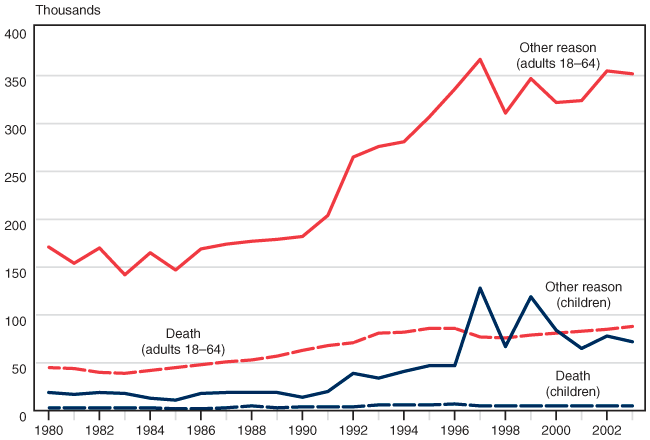
| Year | Children | Adults 18–64 | ||
|---|---|---|---|---|
| Death | Other reason |
Death | Other reason |
|
| 1980 | 3 | 19 | 45 | 171 |
| 1981 | 3 | 17 | 44 | 154 |
| 1982 | 3 | 19 | 40 | 170 |
| 1983 | 3 | 18 | 39 | 142 |
| 1984 | 3 | 13 | 42 | 165 |
| 1985 | 2 | 11 | 45 | 147 |
| 1986 | 2 | 18 | 48 | 169 |
| 1987 | 3 | 19 | 51 | 174 |
| 1988 | 5 | 19 | 53 | 177 |
| 1989 | 3 | 19 | 57 | 179 |
| 1990 | 4 | 14 | 63 | 182 |
| 1991 | 4 | 20 | 68 | 204 |
| 1992 | 4 | 39 | 71 | 265 |
| 1993 | 6 | 34 | 81 | 276 |
| 1994 | 6 | 41 | 82 | 281 |
| 1995 | 6 | 47 | 86 | 307 |
| 1996 | 7 | 47 | 86 | 336 |
| 1997 | 5 | 128 | 77 | 367 |
| 1998 | 5 | 67 | 76 | 311 |
| 1999 | 5 | 119 | 79 | 347 |
| 2000 | 5 | 84 | 81 | 322 |
| 2001 | 5 | 65 | 83 | 324 |
| 2002 | 5 | 78 | 85 | 355 |
| 2003 | 5 | 72 | 88 | 352 |
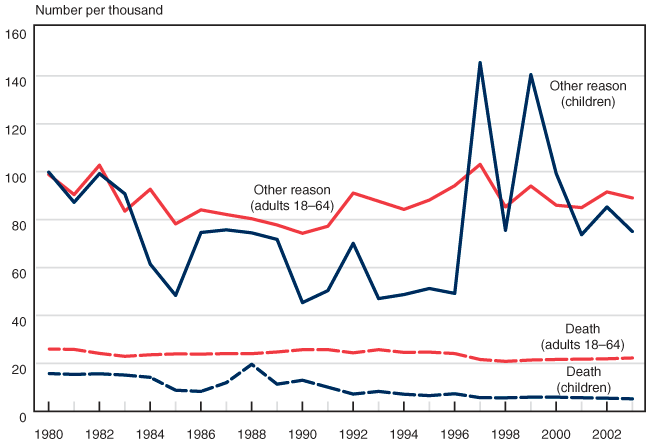
| Year | Children | Adults 18–64 | ||
|---|---|---|---|---|
| Death | Other reason |
Death | Other reason |
|
| 1980 | 15.76 | 99.79 | 26.00 | 98.80 |
| 1981 | 15.39 | 87.23 | 25.84 | 90.43 |
| 1982 | 15.66 | 99.18 | 24.17 | 102.70 |
| 1983 | 15.13 | 90.76 | 22.94 | 83.54 |
| 1984 | 14.18 | 61.44 | 23.59 | 92.67 |
| 1985 | 8.80 | 48.38 | 23.95 | 78.23 |
| 1986 | 8.29 | 74.63 | 23.88 | 84.06 |
| 1987 | 11.96 | 75.73 | 24.07 | 82.13 |
| 1988 | 19.60 | 74.47 | 24.06 | 80.36 |
| 1989 | 11.33 | 71.73 | 24.76 | 77.76 |
| 1990 | 12.96 | 45.37 | 25.72 | 74.29 |
| 1991 | 10.07 | 50.36 | 25.74 | 77.23 |
| 1992 | 7.19 | 70.08 | 24.40 | 91.06 |
| 1993 | 8.30 | 47.05 | 25.73 | 87.66 |
| 1994 | 7.13 | 48.72 | 24.59 | 84.25 |
| 1995 | 6.54 | 51.25 | 24.70 | 88.16 |
| 1996 | 7.33 | 49.21 | 24.10 | 94.16 |
| 1997 | 5.68 | 145.48 | 21.62 | 103.04 |
| 1998 | 5.64 | 75.53 | 20.84 | 85.30 |
| 1999 | 5.90 | 140.49 | 21.40 | 94.01 |
| 2000 | 5.90 | 99.20 | 21.63 | 86.00 |
| 2001 | 5.67 | 73.71 | 21.78 | 85.01 |
| 2002 | 5.47 | 85.26 | 21.92 | 91.55 |
| 2003 | 5.21 | 75.05 | 22.26 | 89.04 |
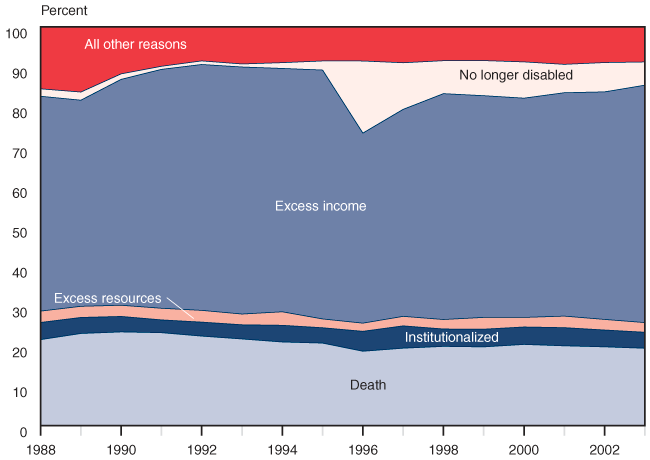
| Year | Death | Institutionalized | Excess resources |
Excess income |
No longer disabled |
All other reasons |
|---|---|---|---|---|---|---|
| 1988 | 21.57 | 4.31 | 2.83 | 53.89 | 1.86 | 15.52 |
| 1989 | 23.11 | 4.03 | 2.78 | 51.70 | 2.04 | 16.33 |
| 1990 | 23.50 | 3.90 | 2.79 | 56.67 | 1.38 | 11.77 |
| 1991 | 23.31 | 3.22 | 2.91 | 59.92 | 0.77 | 9.87 |
| 1992 | 22.45 | 3.52 | 2.93 | 61.67 | 0.90 | 8.52 |
| 1993 | 21.74 | 3.57 | 2.68 | 61.97 | 0.75 | 9.29 |
| 1994 | 20.98 | 4.20 | 3.38 | 61.05 | 1.44 | 8.96 |
| 1995 | 20.70 | 3.86 | 2.20 | 62.43 | 2.27 | 8.54 |
| 1996 | 18.65 | 5.01 | 2.03 | 47.68 | 18.08 | 8.55 |
| 1997 | 19.42 | 5.61 | 2.38 | 51.92 | 11.68 | 8.99 |
| 1998 | 19.87 | 4.38 | 2.37 | 56.65 | 8.26 | 8.47 |
| 1999 | 19.75 | 4.45 | 2.94 | 55.62 | 8.80 | 8.44 |
| 2000 | 20.37 | 4.39 | 2.39 | 55.00 | 9.09 | 8.77 |
| 2001 | 20.01 | 4.57 | 2.88 | 56.04 | 7.11 | 9.38 |
| 2002 | 19.76 | 4.23 | 2.64 | 57.08 | 7.35 | 8.94 |
| 2003 | 19.40 | 4.03 | 2.41 | 59.55 | 5.82 | 8.79 |
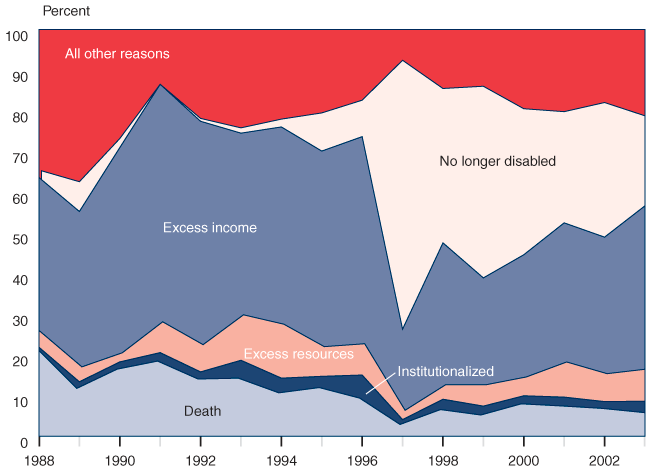
| Year | Death | Institutionalized | Excess resources |
Excess income |
No longer disabled |
All other reasons |
|---|---|---|---|---|---|---|
| 1988 | 21.07 | 0.83 | 4.13 | 37.60 | 1.65 | 34.71 |
| 1989 | 11.79 | 1.63 | 3.66 | 38.21 | 7.32 | 37.40 |
| 1990 | 16.52 | 1.79 | 2.23 | 50.45 | 2.23 | 26.79 |
| 1991 | 18.49 | 2.10 | 7.56 | 58.40 | 0.00 | 13.45 |
| 1992 | 14.08 | 1.76 | 6.69 | 54.93 | 0.70 | 21.83 |
| 1993 | 14.29 | 4.42 | 11.17 | 44.68 | 1.30 | 24.16 |
| 1994 | 10.68 | 3.63 | 13.25 | 48.50 | 1.92 | 22.01 |
| 1995 | 11.98 | 2.78 | 7.29 | 48.09 | 9.38 | 20.49 |
| 1996 | 9.39 | 5.69 | 7.68 | 50.92 | 8.96 | 17.35 |
| 1997 | 2.91 | 1.20 | 2.28 | 19.95 | 66.12 | 7.54 |
| 1998 | 6.57 | 2.55 | 3.53 | 34.91 | 37.96 | 14.48 |
| 1999 | 5.24 | 2.20 | 5.24 | 26.28 | 47.12 | 13.93 |
| 2000 | 7.98 | 2.00 | 4.61 | 30.05 | 35.91 | 19.45 |
| 2001 | 7.46 | 2.19 | 8.63 | 34.21 | 27.34 | 20.18 |
| 2002 | 6.86 | 1.68 | 6.86 | 33.57 | 33.09 | 17.93 |
| 2003 | 5.81 | 2.83 | 7.85 | 40.19 | 22.14 | 21.19 |
Detailed data on the reason for terminations of disabled SSI recipients is available only for 1988 and later years. The data in Charts 40 and 41 for the period 1980 to 2003 are limited to terminations of SSI disabled recipients for death and all other reasons. Charts 42 and 43 show the percentage of terminations by additional categories for a shorter period (1988 to 2003).
The number of deaths of SSI disabled children was relatively constant, while deaths of SSI disabled adults (aged 18–64) rose from the mid-1980s to the mid-1990s. The rate of termination for reasons other than death has varied over time. The total number of terminations for SSI adults peaked in 1997, in part because of program changes in the welfare reform era.
Note, however, that the number of adult SSI recipients found to be no longer disabled (Chart 42) peaked in 1996, following implementation of P.L. 104-121, which mandated the removal of persons for whom drug abuse or alcoholism was a materially contributing factor to their disability. Changes in the SSI program related to welfare reform (P.L. 104-193) resulted in a high number of terminations of disabled children from SSI in 1997. As the result of continuation of payments and reviews of these redeterminations of children, terminations fell in 1998 and rose again in 1999 as final dispositions were entered. The effect of these changes on the size of the SSI program for disabled children is shown dramatically in Chart 43. The percentage of terminations due to no longer being disabled increased dramatically in 1997, then began to tail off. The trend has clearly been toward higher numbers of terminations for reasons other than death.
The death rates were relatively constant for SSI children and adults until downward trends began in the mid-1980s for children and around 1995 for adults (Chart 41). Even though the decline in death rates for children began before the Zebley decision in 1990, there has been a consistent decline in the death rates for children since 1990 that probably reflects, at least in part, changes resulting from the Zebley decision and increased numbers of children with mental disorders receiving SSI.
The rate of termination for reasons other than death has varied over time, particularly for SSI children. The rate of termination for SSI adults peaked twice—in 1982 during the period of accelerated disability reviews and again in 1997 after Congress mandated changes to the SSI program (Chart 41). Terminations of SSI children for reasons other than death peaked twice, once in 1997 and again in 1999. In 1996, welfare reform legislation changed the statutory definition of disability for children and ordered redeterminations of cases allowed on the basis of the criteria resulting from the Zebley decision. In 1998, benefit continuation while cases were reviewed and appeals undertaken was offered to children who had been terminated. The final disposition of the welfare reform redeterminations occurred in 1999, resulting in the higher termination rate.
As can be seen in Charts 42 and 43, the impact of Congressionally mandated CDRs for SSI, particularly for children awarded payments because of low birth weight and redeterminations of SSI children reaching age 18, coupled with dedicated CDR funding, resulted in larger proportions of terminations because recipients were found to be no longer disabled. Blind and disabled adult SSI recipients for whom drug abuse or alcoholism was material to a prior finding of disability were no longer considered disabled after 1996, which increased terminations of disabled adult SSI recipients. The various other reasons for termination have represented a relatively constant proportion of terminations for adults, although they have varied somewhat for SSI children.
Notes
1. Terminations from the disabled-worker program are due to death, recovery (medical or a return to work), or conversion to retirement benefits at the full retirement age.
2. See Tim Zayatz, Social Security Disability Insurance Program Worker Experience, Actuarial Studies No. 114 (June 1999) and No. 118 (June 2005) (Washington, DC: Social Security Administration, Office of the Chief Actuary).
3. Before 1990, HIV/AIDS was not counted in the "Infectious and parasitic disease" category but was included in the "Other" category.
4. Before 1990, HIV/AIDS was not counted in the "Infectious and parasitic disease" category but was included in the "Other" category.
5. Other factors included removal of prematurity as a requirement for an allowance based on low birth weight in 1993. Specific impairment codes for low birth weight were adopted in February 1994. Before 1994, low birth weight awards fell under the "Other" category.
6. Although the Secretary of Health and Human Services implemented the nationwide moratorium on CDRs, the governors of many states had ordered the Disability Determination Services to stop conducting CDRs long before that date. CDRs were resumed at a much diminished pace under the medical improvement review standard in 1986.
7. Disabled widow(er)s did not have an increase in their full retirement age (and age of conversion) until 2005, because those who attained the age of 60 in 2000 were the first affected.
8. The history of policy changes that influenced terminations is discussed in greater detail in a later section.